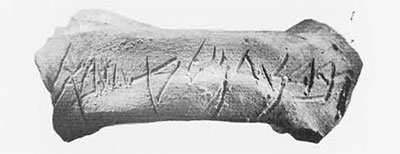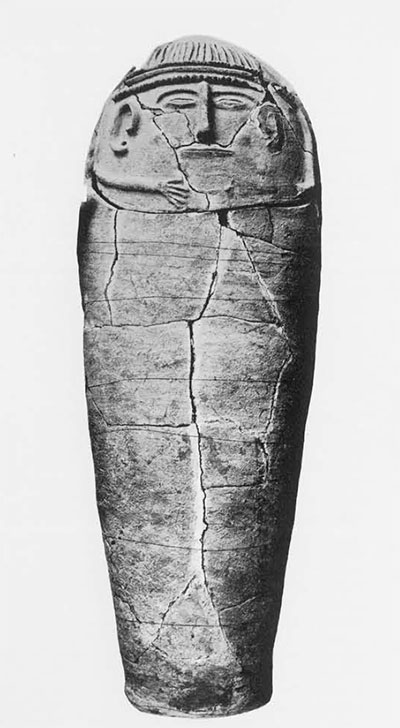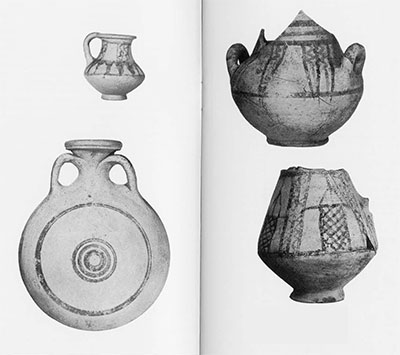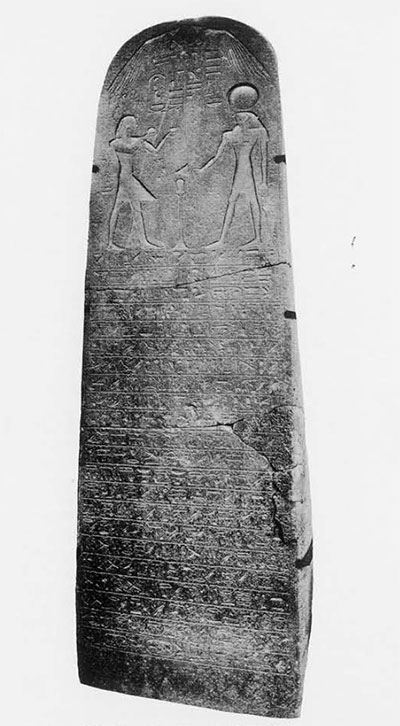Palestine was always a very poor country, but at the same time it was a land bridge between continents. As such it was also one of the most important regions through which ancient caravans and trade routes crossed and met each other. All direct communication by land between Arabia and the Mediterranean world had to pass through or near Palestine. Palestine was a link connecting such wholly different civilizations as those of Egypt and Mesopotamia or of the Hittites and the South Arabians. In Palestine we find samples of many kinds of culture. There are imported objects as well as objects left at a site some one of the many different cultures which succeed one another in this country. The late Clarence Stanley Fisher, who was for many years associated with the University Museum of the University of Pennsylvania while excavating in Iraq, Egypt, and elsewhere, used to say that he preferred to dig in Palestine because it was only in Palestine that one could find so many different cultures represented. For example, one day he might find an Egyptian stela, the next day he might dig up a cuneiform letter. Another day he might find objects belonging to a Philistine garrison which had come from the Aegean and brought many elements of foreign culture with it.
But Palestine is much more important than one might infer from such a glimpse. It was also the land of the Bible. Bible lands extend from Spain and Northwest Africa to India, from Southern Russia to the Indian Ocean, a tremendous span in space as well as in time. But Palestine remains the home of Israel and the place where most of the Old Testament was written. The Old Testament is a unique historical monument which is far older than anything else preserved through ancient and mediaeval transmission to modern times. The oldest parts of the Old Testament are much earlier than anything in Greek literature, even the Homeric epics. The Israelites wrote with extraordinary attention to historical detail. Not until we reach Thucydides can we see in Greek literature anything comparable to the best Old Testament writing in this respect. It is, however, natural that there should be a long debate about the degree of historicity. How historical is the Old Testament? Of course, form one point of view all the Old Testament is historical because all of its parts reflect an historical situation, a situation in which its authors lived. I am, however, referring more specifically to events which had to do with the Hebrew people, the nation of Israel, and the actions of the kings and leaders of Israel in antiquity. Here we have an unparalleled opportunity to test the reliability of oral and written tradition, until recently known only from manuscripts of the Middle Ages, beginning in the fourth century A.D.
Without insisting on the historical character (in a pragmatic sense) of every statement in the Old Testament, we can say with confidence that archaeology is fully demonstrating its reliability as a historical source. Prof. E.A. Speiser of the University of Pennsylvania called attention a number of years ago to the fact that in a few cases where the Biblical sources and the Assyrian sources refer to the same event, the Biblical reference is generally more accurate. President Nelson Glueck of Hebrew Union College in Cincinnati and the Jewish Institute of Religion in New York City, one of the most distinguished Palestinian archaeologists, has repeatedly spoken of the “extraordinary historical memory” of the Israelite people. Of course we must not go so far as to make any such judgement walk on all fours. There are exceptions, cases where oral tradition was at fault or where later editors misunderstood a situation, but in general we can fully rely on the historical data of the Old Testament.
Palestine has, strangely enough, become one of the most important regions of the world for prehistory. When one says “prehistory” one does so apologetically. One would prefer to have it called “early human history.” The term “prehistory” is misleading, since it suggests that history began only with writing, which is no longer true. In some respects we even can learn more from non-written sources than we can from written sources. I refer only to three well-known developments to illustrate the significance of Palestine for early historical times. During the past two years, it has become known that the northern Jordan valley is unique in its significance for the earliest human history. The geologist, G. Haas, and the prehistorian, Moshe Stekelis, both of the Hebrew University, have discovered, not far from the Sea of Galilee, remains of the so-called Villafranchian period, which carries us back to the early Pleistocene Age before the first glaciation. This is the period of the famous fossil “missing link” known as Zinjanthropus, discovered by Leakey in East Africa several years ago. Zinjanthropus belongs to the so-called Australopithecines, remains of which have recently been found in increasing quantity both in South Africa and East Africa. Now we have these remains in the northern Jordan Valley of Palestine as well. I shall not attempt to date them, in view of the bitter debate going on which is complicated by the use of several methods of geochronology, especially radiocarbon and the new potassium-argon process.
Not only have Haas and his colleagues found the oldest remains of a fossil hominid which can be labeled “human” outside Africa, but we also have from Palestine the first villages with stone-built houses from the lower Mesolithic, that is, from the early part of the transitional period between Paleolithic and Neolithic. These discoveries we owe to Jear Perrot and Moshe Stekelis, who have found a fishing village in the Jordan valley (not far from the remains of Zinjanthropus) as well as another village south of Carmel. The stone-built houses of Eynan ( a fishing village north of the Sea of Galilee) contain remains of successive human settlements which must have lasted a good many years. These phases may have followed each other in rapid succession, but we have to reckon with decades, perhaps even with generations for the length of the Eynan occupation. The site south of Carmel was partly devoted to farming, on a primitive scale to be sure, like the coeval remains excavated near Athlit by Dorothy Garrod. Naturally, at that early age, no pottery was yet known and conditions of life must have been pretty simple, yet art was by no means negligible and men must have been able to live together in reasonably stable communities (about 10,000 years ago, according to radiocarbon evidence).
Thirdly we have the Pre-Pottery Neolithic which has been discovered in Jericho by Kathleen Kenyon and north of Petra by Diana Kirkbride. In the past few years Pre-Pottery Neolithic settlements have also been found in Greece and Asia Minor, on Cyprus, and as far east as Pakistan, so there can no longer be any doubt that the Near and Middle East was the home of a wide-flung and flourishing Neolithic culture which contained fine walled towns as well as villages–all without any pottery.

Turning to historical periods in the strict sense, I can refer only to a few outstanding excavations during the past few years, since the number is increasing rapidly and many small undertakings are extremely important. I shall mention only the work at Hazor, Shechem, Gibeon, and Jerusalem. At Hazor, Yigael Yadin dug for four years (1955-58), uncovering parts of the most extensive walled city yet found in Palestine, covering something like a hundred acres. Yadin estimates that at the rate of progress of this excavation during those four years it would take 800 years to excavate the site. Four years have now passed without excavation there and so at the rate of work since the beginning of 1955 we should have to estimate the duration of the whole excavation at 1600 years! Hazor is a very large site and in places very deep, with remains extending from the Early Bronze Age (or earlier) down to the Persian period; there was a large and rich city there during the Middle and Late Canaanite periods between about 1700 and 1200 B.C. Excavations have clarified every phase of the history of ancient Palestine and there can be no doubt that even more important finds are right under the surface. Some day archives of cuneiform tablets will be found at Hazor as at other large towns of Greater Syria.
Second, I want to refer to G. Ernest Wright’s excavations at Schechem (1956-). Here we have one of the most important towns of ancient Palestine from the standpoint of its situation as well as its significance in the history of Israel. There are many problems which have not hitherto been solved because of lack of properly organized excavations. Work had been done here by an Austro-German excavation, to which we owe important finds of fortifications, buildings, and objects. This excavation did not employ the pottery criterion for chronology until its last campaign in 1934, so almost everything was left for the future to solve. Today, thanks to the excavations of Wright and his colleagues, we have a very careful chronology of the site from the early second millennium on down to the last century B.C. The excavations here are epoch-making in the light they shed on the settlement of Israel in Palestine.



A third dig of great importance was also begun by James B. Pritchard at Gibeon in 1956. Pritchard (now professor at the University of Pennsylvania and curator of the Section of Biblical Archaeology in the University Museum) has recently returned from his latest season at this site with extremely interesting and important results. Gibeon was also a place of great importance in the history of Israel and yet very little was understood about its history, and references to it were sometimes explained in diametrically opposite ways by different scholars. Pritchard’s work has made it certain that Gibeon was indeed occupied in the days of Joshua, but that it was much less important than the later editor of Joshua (probably writing in the seventh century B.C.)supposed. Presumably the editor was influenced by the impressive location and size of later Gibeon. Gibeon is one of the first Biblical towns in Palestine to yield absolutely certain proof of its correct location, since dozens of excavated jar handles bear the name “Gibeon,” with other details showing that the wine which was stored in the jars upon which inscriptions are found, actually came from Gibeon. Many other interesting discoveries have been made at this site, which now becomes one of the most important sites to be dug by Palestinian archaeologists.
Since 1961 Kathleen Kenyon, after many campaigns of excavation at Jericho, has turned to Jerusalem itself, where she has been carrying on extremely interesting and successful excavations. For the first time completely modern scientific method has been introduced into this ancient city, at least on a large scale. Her discoveries are now clearing up many puzzles and obscurities in the history of the city.
Finally we shall discuss the use of pottery for dating Biblical history. I shall take up the following illustrations: (1) fixing the date or Abraham by Nelson Glueck’s explorations in the Negeb of Palestine; (2) the date of the conquest of Canaan by Israel under Joshua; (3) the character of the building operations of Solomon; (4) the destruction of the cities of Judah by the Chaldaeans in the early sixth century B.C.; and finally (5) the dating of the Dead Sea Scrolls.
During Nelson Glueck’s remarkable explorations in the Negeb of Western Palestine since 1953, he has found a large number of Middle Bronze I sites, which have subsequently been traced almost to the frontier of Egypt proper by Beno Rothenberg. All these settlements were dated to this period by their pottery. (If one prefers to use Miss Kenyon’s terminology one may call this period Early Bronze-Middle Bronze.) In any case, this pottery is very distinctive and can virtually never be confused with pottery from any other period in Palestinian history. This phase of the period dated roughly between 2000 and 1800 B.C. It was almost invariable found in sites where no earlier or later pottery at all occurred. Near many of these sites there were unquestionably important caravan routes which made it possible for the settlements to be connected with trade, and especially with the caravaneers who organized the great donkey caravans which were such a feature of Western Asia in the late third and early second millennia B.C.
If we turn to the Book of Genesis we see that Abraham’s activities were connected with trading centers and trade routes; he is explicitly said to have lived in Gerar or Hebron near the southern edge of the hill country of Palestine and to have spent his time in the south country between Egypt and Palestine. Without going into too much detail, it may be said that the traditions regarding Abraham fit beautifully into the situation recovered by Nelson Glueck and first connected by him with Abraham. I myself have recently done a considerable amount of work on this problem, incidentally proving that the term “Hebrew” meant originally “donkey caravaneer.” The question will, of course, be debated for some time to come but as new evidence accumulates there will be, I am sure, less and less doubt about the main outlines of the picture. We can now understand the career of Abraham far better than we could, and his date may be set with considerable confidence in or about the nineteenth century B.C.
I want next to discuss the date of the conquest of Canaan by Israel in the time of Joshua. Since the Hebrews are first known to have been in Palestine in the time of Abraham, about the nineteenth century B.C., it is unlikely that there was any century of the second millennium during which the Hebrews did not make some step toward occupying Palestine. The main phase of the conquest, which was associated by Hebrew tradition with Joshua, has been dated all the way from the fifteenth to the twelfth century.
Among the towns mentioned as captured by Joshua are Jericho, Lachish, Bethel, Debir, Hazor, and many others. We have a list of thirty-one towns captured by Joshua in the twelfth chapter of the book which bears his name. The list itself is of late date; it includes not only towns which were taken by him but also other towns which were brought into the tradition by a sort of snowballing process, attributing more and more to Joshua. However this may be, it is quite clear that Biblical tradition places Joshua a little after Moses. Archaeological research proves that the most significant destruction and following change of culture in these towns during the latter part of the Late Bronze Age, between the fifteenth and the twelfth century B.C., took place in the middle of later decades of the thirteenth century.
If we examine the archaeological situation in the towns in question as well as in other towns which were destroyed about the same time, we note the following facts. In the first place, there was a general destruction of fortified towns in the hill country and the low hill country (the so-called Shephelah) about the second half of the thirteenth century B.C. Some towns were not reoccupied for a long time after this destruction. Other towns were occupied almost immediately afterwards. But even where we have evidence for re-occupation after only a short period of abandonment, we find that the culture is quite different. The destruction at that time is also often much more intensive than other destructions of earlier and later date. In short, we can now, through pottery chronology, assisted by inscriptions and other archaeological data, place the campaigns of Joshua in or about the second half of the thirteenth century B.C., just as we should have to infer from the Amarna Tablets and from other cuneiform documents found in Late Bronze Age Palestine, as well as from the Egyptian inscriptions themselves. In short, there is no evidence for anything remotely resembling the conquest of Palestine by Joshua in the fifteenth or fourteenth century, and by the twelfth century the Israelite occupation was well advanced. A great deal more might be said in this connection, but this is, I think, one absolutely certain result of archaeological investigation in Palestine. The fifteenth or fourteenth century dating of the conquest by Joshua has no archaeological basis whatsoever.
Then let us take up the building operations of Solomon. Much is said about them in the Bible, but the traditions about Solomon’s building operations–temple, palace, and fortification of towns–must be submitted to archaeological control before we can be sure that we are not dealing simply with later guesses, as held by some scholars. In the first place, it has been shown that the temple of Solomon itself has a great many archaeological parallels from the early Iron Age, so that the Temple and its principal gateway, described in detail by Ezekiel, carry us back to about the tenth century B.C. But this evidence is still not as decisive as the evidence of pottery chronology when applied to stratigraphic investigations of towns which are said to have been built or fortified by Solomon. Working in Gezer, Macalister found remains which he was unable to interpret, but which Yadin has now shown to be characteristically Solomonic. Then came the American excavations at Megiddo in the thirties of this century, which proved that a certain type of gateway and certain important building remains ought to be associated with Solomon. Thirdly came the work of Yigael Yadin at Hazor, which fixed the stratum of Solomon (stratum 10) beyond any reasonable doubt and found the same kind of building remains. Yadin then went to Megiddo and made soundings there which showed that the American excacators hade made certain mistakes in their conclusions, and that all three sites, Hazor, Megiddo, and Gezer, had city walls of the same casement type, city gates with the same six bays, and other similar features in common. Furthermore, Nelson Glueck, in his work at Tell el-Kheleifeh, found a similar mud-brick gateway and copper refineries with pottery of the tenth-ninth centuries B.C. His work there convinced him, as it has most archaeologists, that this was Biblical Ezion-geber, where the fleet of Solomon started on its voyage down the Red Sea to ancient Ophir.
The nature of the events described in 2 Kings and Jeremiah, as well as Ezekiel, has often been debated in recent years, some distinguished scholars going so far as to deny the historicity of Biblical tradition about the conquest of Judah by the Chaldaeans. However, excavations in the towns of Judah proper (not including those towns which were outside the northern or southern limits of Judah in the last phase of its independent history in the early sixth century B.C.) have shown that all of these sites were destroyed and not reoccupied immediately or even at all. Excavation after excavation has yielded the same result, proving in the most clear-cut fashion that the radical critics are wrong and that there actually was a thorough devastation and depopulation of Judah at the time of the Chaldaean invasions under Nebuchadnezzar, king of Babylon. There were three periods of destruction and depopulation, one in 597, a second in 587, and a third in 582; but the destruction of 587 was the most important. This dating is established by inscriptions, including the famous ostraca of Lachish, as well as by the overwhelming evidence of pottery. North of Judah proper, the territory of Gibeon, Bethel, and Tell en-Nasbesh (excavated by Bade) was outside the limits of the kingdom of Judah in the sixth century B.C., when those cities belonged to the Babylonian governor of Samaria.
Finally, we should say something about the Dead Sea Scrolls. When these Scrolls were first discovered by Bedouin in 1947, the Bedouin took out quite a bit of pottery, and in 1949 the original cave was excavated by Father R. de Vaux. The vases were at once dated to the Hellenistic-Roman period, but there was some fluctuation in detail among archaeologists. For instance, there was a brief period during which the excavators were inclined to date the cave occupation–in other words, the pottery which was found in it–to about 100 B.C. That was theoretically possible, so far as one could judge from the shape of the jars, but as soon as I saw the texture of the first of these jars which came to this country, I recognized that it could not possibly go back earlier than the Roman period, since there was a very abrupt change in the texture of pottery between the early first century B.C. and the end of the same century. From then on the texture of pottery became what we call Roman–a brick-red texture, quite different from that of earlier Hellenistic pottery. Much more pottery has since been found in the adjacent settlement, the monastery of Qumran. Now we have not only pottery of the first cave, but also a great deal more, which has been beautifully classified and dated by Paul Lapp, now director of the American School of Oriental Research in Jerusalem. All of this pottery can be related to other similar pottery from Palestine and neighboring countries and can be dated with the aid of coins. Hundreds of coins were found by Father de Vaux and his associates in digging the site of the monastery at Qumran and the settlement below Qumran at Ain Feshkha, just above the present shore of the Dead Sea. Dating by coins has confirmed the earlier dating by pottery, which itself agreed fully with the evidence of paleography, i.e. by studying the script of the manuscripts and comparing it with the script of other written remains from the lsat centuries B.C. and the first centuries A.D. In short, wherever we can check we have full agreement between the evidence of pottery, of inscriptions, and, in later times, of coins. I might add that in earlier times, except where there is a precious object that may have remained in use a long time, we can virtually always find complete agreement between dating form inscriptions and dating from pottery found in the same contexts.
We are now beginning a new period in the archaeology of Palestine, as well as in the historical understanding of the Bible. These two disciplines must work together; separately they lose a great deal of their value.
